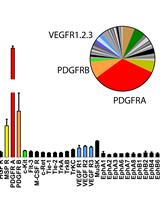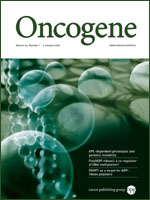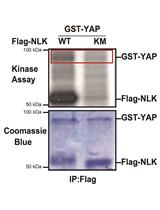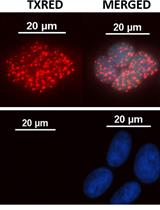- EN - English
- CN - 中文
Detection of ALT Associated Promyelocytic Leukemia Nuclear Bodies (APBs) by Immunofluorescence-FISH (IF-FISH)
免疫荧光原位杂交法(IF-FISH)检测ALT相关的前髓细胞性白血病核体(APB)
发布: 2014年12月05日第4卷第23期 DOI: 10.21769/BioProtoc.1303 浏览次数: 14356
评审: HongLok LungAnonymous reviewer(s)

相关实验方案

利用小鼠Phospho-RTK Array试剂盒无偏筛选肿瘤提取物中激活受体酪氨酸激酶
Julian Naipauer [...] Enrique A. Mesri
2019年04月20日 5637 阅读
Abstract
The activation of functions that counteract the physiological shortening of telomeres in rapidly proliferating cell is prerequisite for the progression of cancer cells to full malignancy (Collado et al., 2007). In most human cancers, the length of telomere is maintained through up-regulation of telomerase whereas a telomerase-independent pathway, termed Alternative Lengthening of Telomeres (ALT) is active in about 10-15% of cancers (Johnson and Broccoli, 2007; Heaphy et al., 2011). One characteristic feature of ALT is the formation of ALT-associated Promyelocytic Leukemia nuclear bodies (APBs) (Lang et al., 2010; Yeager et al., 1999). APBs contain Promyelocytic Leukemia nuclear bodies (PML-NB) components such as PML, SP100 and SUMO, telomeric DNA and telomere associated proteins including the shelterin components TRF1, TRF2, POT1, TIN2, TPP1 and Rap1 (Yeager et al., 1999). In addition, APBs contain proteins involved in DNA repair. In particular, the presence of components of the homologous recombination machinery suggests that APBs may promote telomere elongation by facilitating the homologous recombination of telomeric templates (Nabetani et al., 2004; Stavropoulos et al., 2002). This is also supported by the requirement of the homologous recombination-associated MRN complex for APB formation (Wu et al., 2000). Furthermore, APBs are suggested to be active sites of ATM and ATR dependent DNA repair (Nabetani et al., 2004). Finally, the number of APBs increases in G2 phase of the cell cycle when recombination is mainly active (Grobelny et al., 2000). We have shown that infection of normal and malignant B lymphocytes with the human oncogenic herpesvirus Epstein-Barr virus (EBV) is associated with the induction of APBs and with numerous signs of chromosomal and genomic instability (Kamranvar et al., 2007; Kamranvar and Masucci, 2011; Kamranvar et al., 2013).
Here we describe a method for detection of APBs in human B-lymphocytes. The method can be applied with minor modifications to different cell types including adherent, suspension and primary cells.
Materials and Reagents
- Cells (suspension cells)
- Formaldehyde (Merck KGaA, catalog number: K43634203 228 )
- Triton X-100 (Sigma-Aldrich, catalog number: T9284 )
- BSA (Sigma-Aldrich, catalog number: A7906 )
- Blocking reagent (Roche Diagnostics, catalog number: 11096176001 )
- Maleic acid (Sigma-Aldrich, catalog number: M0375 )
- Deionized formamide (Merck KGaA, catalog number: K25761484 902 )
- Tris-HCl
- Green-fluorescent Alexa Fluor® 488 (Life Technologies, InvitrogenTM, catalog number: A-11034 ) or Red-fluorescent Alexa Fluor® 594 (Life Technologies, InvitrogenTM, catalog number: A-11005 )
- Ethanol (Kemetyl, catalog number: 200-578-6 )
- Cy3-TelG (PANAGENE, catalog number: F1006 )
- FITC-TelC (PANAGENE, catalog number: F1009 )
- DAPI (Vector Laboratories)
- Fixation buffer (see Recipes)
- Permeabilization buffer (see Recipes)
- IF blocking buffer (see Recipes)
- FISH blocking solution (see Recipes)
- Maleic acid buffer (see Recipes)
- PNA probes (see Recipes)
- Hybridizing solution (see Recipes)
- Washing solution (see Recipes)
- PML antibody (see Recipes)
- Secondary antibody (see Recipes)
- Dehydration solution (see Recipes)
- Mounting medium (see Recipes)
Equipment
- Microscope glass slide (76 x 26 mm)
- Coverslip (preferably circular 19 mm diameter)
- Cytospin or slide centrifuge (Cytospin3 SHANDON)
- Cytospin funnel with white filter card
- Metal holder
- Hydrophobic barrier pen (ImmEdge Pen, model: H-4000 )
- Hot plate preheated to a temperature 80 °C
- Coplin jar
- Moist chamber
Procedure
文章信息
版权信息
© 2014 The Authors; exclusive licensee Bio-protocol LLC.
如何引用
Kamranvar, S. A. and Masucci, M. G. (2014). Detection of ALT Associated Promyelocytic Leukemia Nuclear Bodies (APBs) by Immunofluorescence-FISH (IF-FISH). Bio-protocol 4(23): e1303. DOI: 10.21769/BioProtoc.1303.
分类
癌症生物学 > 增殖信号转导 > 生物化学试验 > 蛋白质分析
癌症生物学 > 无限复制 > 生物化学试验 > DNA结构和改变
细胞生物学 > 细胞染色 > 核酸
您对这篇实验方法有问题吗?
在此处发布您的问题,我们将邀请本文作者来回答。同时,我们会将您的问题发布到Bio-protocol Exchange,以便寻求社区成员的帮助。
Share
Bluesky
X
Copy link












